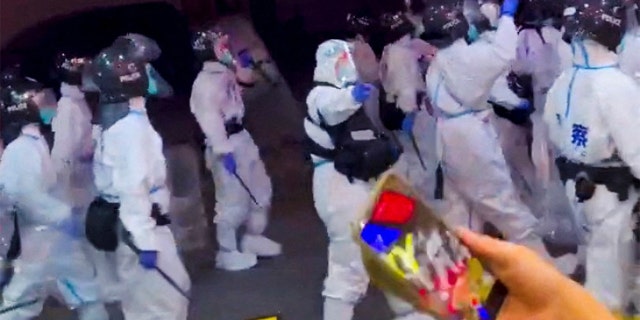The communist regime in China is relaxing some of its strict “zero-COVID” policies after anti-lockdown protests in major Chinese cities led to violent clashes with state authorities.
China’s National Health Commission said Wednesday that people with asymptomatic cases of COVID-19 and those with mild symptoms can now isolate themselves at home instead of being forced into a state-run quarantine facility. In addition, authorities are easing testing requirements and travel restrictions within the country, according to a 10-point plan released by the health authority.
“Asymptomatic people and mild cases can be isolated at home by reinforcing health monitoring and can be transferred to designated hospitals for treatment in a timely manner if their condition deteriorates,” the NHC said.
Also, in a dramatic change, blocks will now be limited to single floors and apartment buildings instead of entire districts or neighborhoods. Controlling the nucleic acid test on a smartphone app is no longer required for travel to most places except day care centers, senior homes, and schools. Restrictions on buying over-the-counter cold and flu medicines have also been lifted. Businesses will be able to reopen in “non-high-risk areas”. Additionally, schools have been mandated to restore in-person learning where there are no outbreaks of the virus.
BEIJING BELIEVED: CHINESE CITIZENS ‘STRENGTHENED’ AFTER COVID PROTESTS, CHINESE RESEARCHER SAYS

A resident takes off a mask during the COVID test in Beijing on Wednesday, December 7, 2022. In a sharp reversal, China has announced a series of measures that roll back some of the most draconian anti-COVID-19 restrictions.
(AP Photo/Ng Han Guan)
The latest changes are “baby steps” in a gradual process aimed at ending restrictions, Liang Wannian, a member of an expert group advising the National Health Commission, said at a news conference.
“We will examine, study, judge and analyze it again,” said Liang, a top Chinese anti-epidemic expert.
The government’s goal is “to return to the state before the epidemic, but the realization of the goal must have conditions,” Liang said.
These changes bring China into line with the rest of the world, as countries have moved away from restrictions due to the emergency pandemic and are learning to live with COVID-19.
THE WHITE HOUSE SAYS US DIPLOMATIC CHANNELS IN CHINA MAY ‘EXPAND’ AFTER BIDEN’S XI MEETING

Residents wait in line for routine COVID-19 testing at a coronavirus testing site as authorities begin to ease some virus checks in Beijing on Wednesday, Dec. 7, 2022.
(AP Photo/Andy Wong)
However, China didn’t reverse its policies until protests erupted following the deaths of at least 10 people trapped in an apartment building that caught fire during the lockdown. People who were burned alive were unable to escape the building because fire exits were reportedly blocked by pandemic barriers.
Public outrage over the deaths was expressed in widespread mass demonstrations against China’s draconian “zero-COVID” policy. In Shanghai, some protesters shouted politically explosive calls for the resignation of Chinese President Xi Jinping, China’s most influential figure in decades.
Videos posted on social media showed police dragging protesters into custody and dispersing demonstrations with pepper spray and other anti-riot tactics. A BBC reporter covering the protests was arrested and allegedly beaten by police, and hazmat-suited law enforcement officers were deployed to violently crack down on protesters in Guangzhou.
PROTESTANTS IN WUHAN, CHINA SEEN PUSHING THROUGH BARRIER AS US Senators Warn Violent Crackdown

Riot police in personal protective suits arrive during protests against COVID-19 restrictions, in Guangzhou, Guangdong province, China, in this screenshot taken from a social media video posted on Nov. 29, 2022.
(Video obtained by Reuters/via REUTERS)
China has not officially stated that the COVID-19 policy changes were in response to the protests. The easing is in line with pledges to reduce the human cost of “zero-COVID,” including changes announced ahead of the protests that included shorter quarantines for travelers from overseas.
However, the changes come as Chinese authorities reported a surge in COVID-19 infections that began in October. The government reported 25,231 new cases on Wednesday, including 20,912 without symptoms.
Xi’s government has cited “zero-COVID” as proof of the superiority of the Chinese system over the United States and Western countries. The official death toll in China is 5,235 since the start of the pandemic compared to a US tally of 1.1 million.
CLICK HERE TO GET THE FOX NEWS APP
Beijing has not rescinded its goal to end transmission of the virus, which has killed 6.6 million people worldwide.
The Associated Press contributed to this report.
